DENNY'S INDIA
December 1997
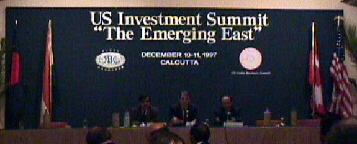
Calcutta, India was the site of "The Emerging East" US Investment Summit that Denny was invited to attend in mid-December. Secretary of Commerce Daley came with a large delegation of US business representatives. Denny was very busy for three days assisting those companies that were working on large infrastructure projects in India, Bangladesh and Nepal. He had only one evening and the morning of his flight to New Delhi to take in some of the sights of Calcutta. A few impressions follow.
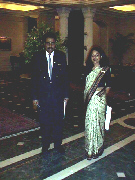
The conference was held in a beautiful old colonial relic -- the Oberoi Grand Hotel. Even more elegant than the marble floors and the Corynthian pillars were the exquisite staff. The women in their gorgeous silk saris and the men in their wastecoats gave the place a very romantic aura.
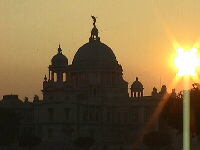
It was nearly dark when Denny grabbed a hotel car on his last evening and went out to catch a glimpse of Calcutta. The sun was already setting on the Victoria Memorial. The park-like setting of these old British colonial artifacts contrast with the crowded bustling streets of old Calcutta.
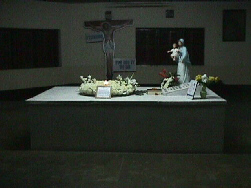
Down a narrow dirty lane in the worst part of Calcutta, Denny found the grave of Mother Teresa. It is in a simple concrete building that houses the convent she headed. It looks more like a skidrow warehouse than a shrine to a saint. The convent was closed, but Denny just walked in through the open door. Periodically, a nun would come and pray with her head resting on Mother Teresa's concrete sarcophagus. Their shoulders would shake with uncontrollable sobbing. These must have been nuns who served under her. What kind of person inspires such profound emotion several months after her death? Denny was moved. He made a donation in the name of his mother-in-law Livia Lim who is a devout Catholic.
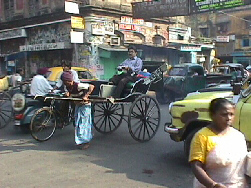
The New Delhi airport was fogged in on the day Denny was to leave. His delayed departure gave him an unexpected windfall -- a couple of hours to explore the streets of Calcutta. It is a time warp. Rickshaws from another century and odd Indian cars that look like something from the 1940's. The city is certainly poor, but Denny was impressed with how vibrant it is. It did not seem poor in spirit. He remembered Mother Teresa's statement when visiting the States that she had never felt such poverty as she experienced in the US. In Calcutta, one understands that there are some important things that are not expressed in per capita GNP.

After spending a long Friday at the Calcutta Airport, Denny finally arrived in New Delhi. The US Embassy staff in New Delhi arranged a very full schedule of meetings for Denny including a workshop he conducted for the American Business Council. Commercial Attache Mike Benefiel was great but local employee Manjushree Phootan did most of the work. She is from Assam State in the Northeast and her near Tibetan look reminds one of what a diverse country India is.

Denny had a full Saturday and Sunday to get out of his business suit and into the real India. Of course, the first thing he did was to make arrangements to get to Agra to see the Taj Mahal. The driver for the perilous four hour bus trip appropriately called himself "Lucky" Baba. He is a very colorful fellow from Kashmir who aspires to be a rock musician. Punjabi and Hindi rock songs blared from the bus loudspeakers in the early morning hours as he drummed out the beat on the steering wheel while deftly swerving around oncoming cars and trucks.
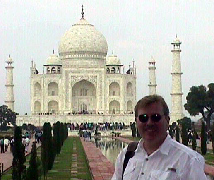
The Taj is indeed an amazing place. Apart from its stunning craftsmanship, it represents the extremes of romantic love. The Moghul leader Shah Jahan spent nearly two decades building it as a mausoleum for his beloved wife who died in childbirth. He nearly bankrupted his Kingdom in the process, but what a great treasure he left for posterity. The translucent white marble has a dreamy moon-like quality. All kinds of gemstones are inlaid in the marble like stars shining in a moon lit night.

The Taj is located on a tranquil meandering river. Originally, Shah Jahan intended to built a black marble twin structure on the other side of the river for his mausoleum. His vision was regarded as madness by some. His third son and many of his subjects turned against him.
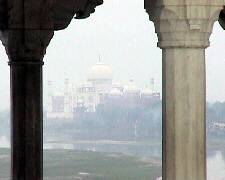
Shah Jahan's third son killed his two older brothers and conspired with the rest of his siblings to imprison his father. The third son then ascended to the throne. Shah Jahan was imprisoned for the rest of his life in the Red Fort just across the river from the Taj where he could gaze daily upon his wife's final resting place. When he died, they buried him next to his wife in the Taj Mahal destroying the otherwise perfect symmetry of the structure.

There are lots of snake charmers in India ready to amaze the tourists for a few rupees. As roughly as they handle the snakes, there does not appear to be much of an art in it. Hopefully, the cobras are defanged.
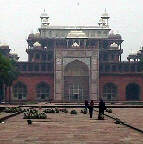
Denny also visited Akbar's Tomb between Delhi and Agra. Even more interesting than the red sandstone structure were the hundreds of monkeys that populated the place.
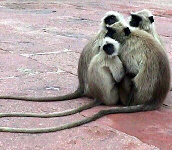
The monkeys were quite tame and appeared to subsist on the food given to them by the tourists. Having witnessed a few monkey muggings in Malaysia, Denny is not overly fond of scavenger monkeys. Actually these were not very aggressive. Maybe the weather caused them to "chill out" a bit. It was unseasonably cold for this part of India, about 50 degrees and they huddled together for warmth.
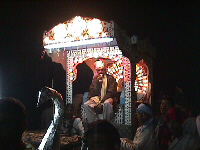
All kinds of amazing sites shot past just outside the bus window on the way back. There were elephants with loads bigger than them, camel carts, and hordes of Indians in the most amazing dress that looked like the roots of Woodstock. When we spotted this colorful local wedding procession we insisted on stopping. This is the groom on his lighted peacock throne being escorted to the bride's house in a riotous parade.
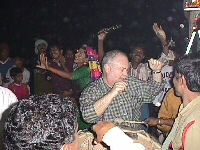
Eli, an exuberant Israeli tourist, decided to join the wedding dance. Later we had to explain to him that the young woman with whom he was dancing was in fact no woman. In rural India, no respectable woman could dance in public so a man dances the woman's part. Things are not always what they seem in India.
CLICK BACK TO THE BARNES FAMILY HOMEPAGE
 Barnes Family Homepage
Barnes Family Homepage